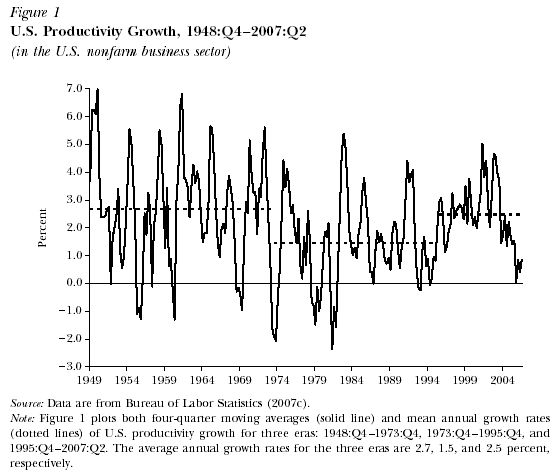If you ain’t making it, you can’t consume it. Productivity growth is the brass ring for any economy concerned with increasing its living standards (there I go anthropomorphizing again). When you can make more things with the same number of people, or make the same amount using fewer people, every individual’s command over resources improves.
This winter’s Journal of Economic Perspectives has a symposium on U.S. productivity. Some highlights:
1. From Jorgenson, Ho and Stiroh describing this picture:
We will argue that the sources of productivity growth have changed twice since 1995. The productivity growth from 1995 up to about the dot-com crash of 2000 was driven by productivity growth in the information-technology-producing sectors and the massive investment in the information-technology- using sectors. While the contributions of information technology to productivity growth remain large in relation to the relative importance of information technology production in the U.S. economy, information technology appears much less important after 2000, as both the contribution from the production and use of information technology have receded from the phenomenal rates observed in the late 1990s. Since 2000, the sources of productivity growth have shifted as total factor productivity growth outside of the production of information technology increased.
So, the rise of information technology took us out of the doldrums and dark matter has kept us from slipping back (although recent productivity numbers show us falling back to doldrum like rates). That dark matter, or “total factor productivity” is econo-speak for “anything that we can’t measure.” You might think of it as ideas or entrepreneurialism or something else … Their conclusion probably upsets some people who are running for political office on themes that the U.S. is going to hell in a handbasket:
Information technology will continue to have a positive impact on the U.S. economy. Given flexible labor markets, competitive product markets with relatively low barriers to entry, and the deep, sophisticated, capital markets that characterize the U.S. economy, the country should be well-position to continue to innovate and benefit as improved technologies emerge.10 As a consequence, there is little reason to expect that the U.S. economy will revert all the way back to the slower pace of productivity growth of the 1970s and 1980s.
2. From van Ark, O’Mahoney and Timmer (comparing the productivity gap between the U.S. and Europe):
The benefits of the modern knowledge economy differ greatly between advanced economies. Average annual labor productivity growth (measured as GDP per hour of work) in the United States accelerated from 1.2 percent in the 1973-1995 period to 2.3 percent from 1995 to 2006. Conversely, the 15 European Union countries that constituted the union up to 2004 experienced a productivity growth slowdown between these two time periods. For these 15 countries as a group, labor productivity growth declined from an annual rate of 2.4 percent during the period 1973-1995 to 1.5 percent during the period 1995- 2006. While differences in the timing of business cycles in the United States and the European Union may have some effect on this comparison, they do not explain these divergent trend growth rates. This paper shows that the European productivity slowdown is attributable to the slower emergence of the knowledge economy in Europe compared to the United States.
Their explanations for this reversal revolve around Europe’s slower adopting of information technology, smaller numbers of firms producing technology in Europe and slow advances in dark matter (i.e. innovation, technological advances, etc.) Funny, I was always led to believe that Europe was far more advanced than the U.S. in communications technology. That may be true, someone enlighten me. One obvious solution they propose is, “a more flexible approach towards labor, product, and capital markets in Europe would allow resources to flow to their most productive uses.” Another is for the EU (within) to encourage greater openness of service product markets. That’s sorta how the U.S. federal system works.
